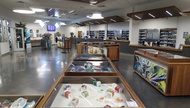Recently, the Environmental Protection Agency restored the climate change section of its website. Scott Pruitt, the Trump-appointed former administrator of the EPA, ordered the web pages removed nearly four years agobecause he rejects the overwhelming scientific evidence that the steady burning of fossil fuels is releasing gases like carbon dioxide and methane—emissions that are trapping heat in the atmosphere and gradually warming the planet. (Unsurprisingly, he’s now registered as a coal lobbyist.)
Green Dream
- A peek inside North America’s largest recycling center, located right here in the Las Vegas Valley
- Vegas vs. Emissions: It’s one of the climate’s biggest foes, and here’s how you can help to beat it
- Analyzing whether Las Vegans should add rooftop solar to their homes
- The Clark County Lands Bill would protect Nevada’s unspoiled acres (and more)
- Friends of Nevada Wilderness restores nature on Earth Day and beyond
- Simple ways to help conserve water in Southern Nevada
- Raising Eco-warriors: Teaching kids to be stewards of the Earth
But the EPA’s climate change pages live again, and their data is easy to check against other scientific studies from around the world. The science on emissions is settled. The planet is warming up, and the causes are human: factory waste, outdated agricultural practices and, closer to home, vehicle emissions. And considering we live in a hot, arid climate—one whose mean average temperature, according to recent data from Nevada’s Desert Research Institute, has been steadily climbing since 1950—it might be healthy for us to actually look at those reinstated climate pages and freak out over them just the tiniest bit.
Vehicle emissions are one of the biggest adversaries in the fight against climate disaster. And here in Southern Nevada, that fight is going … OK. Drivers are slowly warming to the idea of carpooling; in a May 2020 interview, Nevada Department of Transportation rep Tony Illia told me that local use of high-occupancy vehicle lanes “has steadily climbed” since additional HOV miles were added in recent expansions of I-15 and U.S. 95. (And once Raiders home games finally come to Allegiant Stadium and tailgating begins in earnest, those carpool lanes will handily prove their value.)
More people are riding Las Vegas’ city buses, removing huge numbers of emissions-spewing single-occupant vehicles from the streets. “Prior to the COVID-19 pandemic, RTC’s public transit system provided 63.3 million passenger trips in 2017, 64.6 million passenger trips in 2018 and 65.3 million passenger trips in 2019,” Regional Transportation Commission Deputy CEO Francis Julien tells the Weekly by email. The RTC is considering bus rapid transit and light rail solutions that could lure even more riders, including Valley residents who’ve never seriously considered public transportation before—which, let’s be honest, is probably more than half of us.
And even the much-maligned Las Vegas Monorail is working. The nearly 4-mile line carried 4.6 million passengers in 2019, most of them conventioneers—and in so doing, the all-electric train removed an estimated 2.1 million vehicle miles from our streets and some 27 tons of emissions from our air.
The Las Vegas Convention and Visitors Authority acquired the monorail in December 2020, in part to gain right-of-way permissions for a new underground tunnel system created by one of Elon Musk’s companies to run his no-emission electric vehicles; if it proves successful in moving visitors from one end of the Convention Center to the other, the Vegas Loop could be expanded to the Strip, the airport and beyond.
These are all good things. But they’re not nearly enough to make even a small dent in the problem. You only need to look at the veritable parking lot of idling cars the southbound 15 becomes every Sunday to know that our vehicle emissions won’t be so easily reduced. But there are a few more steps we can take, personally and as a community, to save our city from slowly cooking to death.
Share a cab/Lyft/Uber (when we start going out again). In addition to reducing the number of vehicles on the streets, it could save you and your friends a few bucks on gas and parking. Parking fees! They live!
Support efforts to bring train service back to Las Vegas. Whether it’s the Brightline West high-speed rail line from Victor Valley or the restoration of Amtrak service to Las Vegas, we need rail—both to alleviate traffic snarls on I-15 and to reduce the number of single-occupancy vehicles coming to town every weekend.
Support the creation of a light rail line (or more than one). It’s not some rarefied thing: Some 40 U.S. cites have heavily used light rail systems, including neighboring Phoenix and Salt Lake City. According to a 2010 report from the Department of Transportation, light rail systems produce 62% less emissions than private vehicles. (And bus transit produces 33% less.) Also, light rail lines encourage the building of walkable neighborhoods—like the ones already beginning to form in the Arts District, on Maryland Parkway and in Chinatown.
We don’t have to give up being who we are. We can still have one or two gasoline cars in the driveway. We can still take road trips. NASCAR needn’t perish. But if we balance those things out with real mass transit, carpooling whenever possible and—why not?—an occasional walk or bicycle ride, we can fix this thing before it’s too late. It’s essential that we do. All of us need to get on the same climate (web)page.





